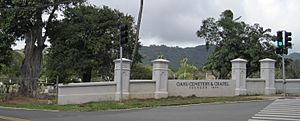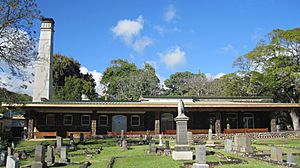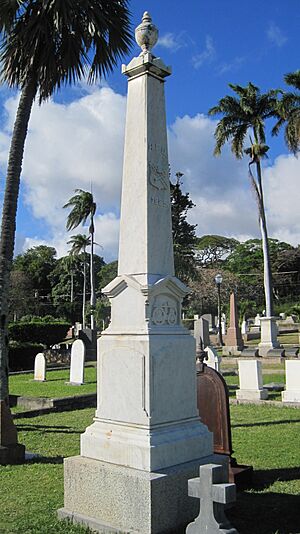Oahu Cemetery facts for kids
The Oʻahu Cemetery is a special place in Honolulu, Hawaii. It is where many important people from early Honolulu are buried. These people include missionaries, politicians, and even sports heroes. Over the years, the cemetery grew bigger. It is now also known as the Nuʻuanu Cemetery.
Contents
History of Oahu Cemetery
The Oʻahu Cemetery was the first public cemetery in Honolulu. It was started in November 1844. Before this, most burial grounds were connected to churches. But as the whaling industry grew, Honolulu needed a new place for burials.
How the Cemetery Started
In 1836, people began talking about needing a new cemetery. The land for the cemetery was bought for $300. It was about 4.38 acres (1.77 hectares). An extra $350 was given for a house. Money was raised by selling 59 burial plots for $12 each. In 1860, the cemetery bought 3 more acres (1.2 hectares) from Gerrit P. Judd to make it larger. Rev. Samuel C. Damon was part of the cemetery's early group. The first person buried there was an American sailor named H. Wolley. His burial cost $2.50.
The Crematory and World War II
In 1906, the first public crematory in the Hawaiian Islands opened at the cemetery. A crematory is a place where bodies are burned. It was designed by an architect named Oliver G. Traphagen.
After the attack on Pearl Harbor in 1941, there was a big worry. The Japanese might invade Hawaii. So, all the paper money on the islands was taken away. It was replaced with special Hawaii overprint notes. This was done so that if the Japanese took over, they couldn't use the regular American money.
The government needed to quickly destroy about $200 million in old cash. It was too risky to send it to the mainland United States. So, the crematory at Oʻahu Cemetery was used to burn the money! But it was too slow. A larger furnace at the Aiea sugar mill was also used to burn the rest.
Special Burial Areas
The cemetery has a special area called the Seamen's Lot. This area has many unmarked graves for sailors. The Honolulu Sailor's Home provided these burial spots.
There is also a plot just for firefighters. It has a tall monument, about 15 feet (4.6 meters) high. Many firefighters were killed during the attack on December 7, 1941. About two dozen died from planes shooting at them.
Nearby Cemeteries
Oʻahu Cemetery is located at 2162 Nuʻuanu Avenue. It is at the start of the Nuʻuanu Valley. In 1863, King Kamehameha IV built the Royal Mausoleum of Hawaii right across the street. This is where the Hawaiian royal family is buried.
Other cemeteries were added nearby over time:
- The National Memorial Cemetery of the Pacific was started in 1948. It is in Punchbowl Crater to the south.
- The "Nuʻuanu Memorial Park" was added in 1949. It is just north of the Royal Mausoleum. It also has its own funeral home.
- In 1958, a Japanese cemetery called "Honolulu Memorial Park" was added next to it.
- In 1964, two Columbaria were built. These are buildings to store cremated remains. They are called the Kyoto Gardens. One of these buildings looks like a Buddhist temple. These gardens are listed on the National Register of Historic Places.
Even though the original cemetery is called "Oʻahu Cemetery," the larger area with all these different burial grounds is often called "Nuʻuanu Cemetery."
Notable Burials
Many well-known people are buried at Oʻahu Cemetery. Here are some of them:
- Captain Alexander Adams (1780–1871), a sea captain from Scotland
- R. Alexander Anderson (1894–1995), a composer
- Lorrin Andrews (1795–1868), a missionary, publisher, and judge
- Andrew Auld (1799–1873), a Scottish shipbuilder
- Joseph Campbell (1904–1987), a philosopher
- George R. Carter (1866–1933), a Territorial Governor
- Alexander Cartwright (1820–1892), known as a pioneer of baseball
- John F. Colburn (1859–1920), a businessman and politician
- William H. Cornwell (1843–1903), a politician
- Samuel C. Damon (1815–1885), a missionary
- Benjamin Dillingham (1844–1918), an industrialist
- Mary Jones Dominis (1803–1889), mother of Prince Consort John Owen Dominis
- Wilhelmine Kekelaokalaninui Widemann Dowsett (1861-1929), who started Hawaii's first women's voting rights group
- Kenneth Emory (1897–1992), an anthropologist
- Jean Erdman (1916–2020), a dancer and choreographer
- Elizabeth P. Farrington (1898–1984), a legislator
- Joseph Rider Farrington (1897–1954), a publisher
- Wallace Rider Farrington (1871–1933), the 6th Territorial Governor
- Grace Crosby Hamman (1899-1983), who directed services for the blind in Hawaii
- Victor S. K. Houston (1876–1959), a naval officer and delegate to Congress
- John Papa ʻĪʻī (1800–1870), an educator and judge
- Gerrit P. Judd (1803–1873), a missionary doctor and diplomat
- Lawrence M. Judd (1887–1968), a Territorial Governor
- Elizabeth Kahanu Kalanianaʻole (1879–1932), a Hawaiian princess by marriage
- Stanley Kennedy Sr. (1890-1968), the founder of Hawaiian Airlines
- Oren E. Long (1889–1965), a Governor and Senator
- J. R. Kealoha (died 1877), a Native Hawaiian veteran of the Civil War
- Lincoln Loy McCandless (1859–1940), an industrialist and delegate to Congress
- Paul Neumann (c. 1839–1901), a royal lawyer and attorney general
- Arthur P. Peterson (1858–1895), a lawyer and politician
- Joseph Rock (1884–1962), an explorer
- Martha Root (1872–1939), a Bahá'í teacher
- Ingram Stainback (1883–1961), a Territorial Governor
- Lorrin A. Thurston (1858–1931), a businessman and politician
- Jules Tavernier (1844–1889), a painter
- Horace Worth Vaughan (1867–1922), a Texas politician and Hawai'i judge
- Four British Royal Navy personnel from World War II.




